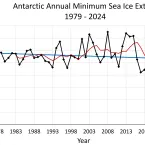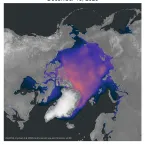Our Research
As climate changes, how do Earth's frozen areas affect our planet and impact society?
In this section
Related News & Stories
Filter by:

Analysis - Sea Ice Today
On February 20, Antarctic sea ice likely reached its minimum extent of 1.99 million square kilometers (768,000 square miles), tying for second lowest extent in the 1979 to 2024 satellite record.

News Release
Antarctic sea ice has likely reached its minimum extent for the year, at 1.99 million square kilometers (768,000 square miles) on February 20, 2024, according to scientists at NSIDC.

Analysis - Ice Sheets Today
Ice sheet surface melt on the Antarctic Peninsula abruptly dropped in mid-January and remained low through February 15. By contrast, melt day totals for the season were above average for the northern Larsen C and George VI Ice Shelves.

Analysis - Sea Ice Today
Arctic sea ice growth was slower than average through most of the month, but with extent slightly declining towards the end of the month.

Analysis - Ice Sheets Today
With the melt season well underway in the Southern Hemisphere, several ice shelves extending from the Antarctic Ice Sheet show above average melting, with significant melting in the Antarctic Peninsula region.

Spotlight
QGreenland is a free mapping tool supported by video tutorials, complete documentation, and a website to help you to get started and continue your learning. The project now boasts a new product release, a revamped website, and funding for enhanced data sharing and interoperability.